| Columns Retired Columns & Blogs |
Monitor Audio Studio 50 loudspeaker Measurements
Sidebar 4: Measurements
Scoring very close to the target sensitivity, the Studio 50 achieved 89.5dB/W/m based on a median drawn through the central five octaves (89dB/W/m B-weighted). This is above-average sensitivity, implying that a wide range of amplifiers will drive this speaker successfully. Choose solid-state if that last ounce of slam and extension is to be wrung from the deep bass. I had wondered whether the '50s impedance would compromise the usefully high sensitivity, but the impedance trace (fig.1) revealed a good result, typically 5–10 ohms over the bulk of the power-dominated frequency range. Only below the box tuning frequency of 55Hz was there a downward trend, leveling out at just below 4 ohms by 20Hz, in my view no great problem.
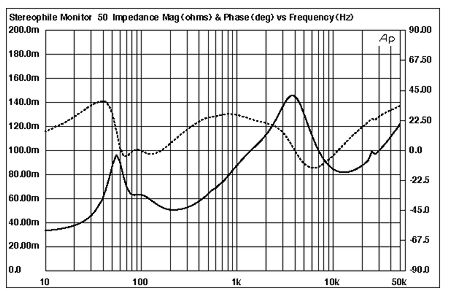
Fig.1 Monitor Audio Studio 50, electrical impedance (solid) and phase (dashed) (2 ohms/vertical div.).
For a typical single-ended tube amplifier with a highish source impedance, there will be little change in sound quality over the broad upper-bass/midrange region, but the Monitor Audio's high-impedance region in the treble—an average of 10 ohms from 2kHz to 8kHz—will result in some increase in treble brightness, 1–1.5dB or so. This might perhaps be compensated for by the generally refined SE character in this frequency range.
Fig.2 shows the individual responses of the four drive-units. The upper crossover may be nominally located at 3.2kHz, but there is substantial overlap, the tweeter hanging until 1.5kHz, supporting the upper midrange, while the midrange unit itself has a its dominant cone-resonance kick at 5.5kHz reaching almost to full level. The top trace to the left of fig.2 is the midrange unit's output, measured in the nearfield. As expected it gently rolls out below 120Hz in an overdamped manner. The two bandpass responses at a lower level are the individual nearfield responses of the two woofers, plotted to scale. Both show a degree of resonant behavior in the midrange, but this is down in level.
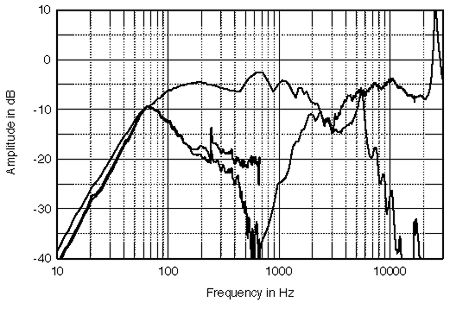
Fig.2 Monitor Audio Studio 50, acoustic crossover on tweeter axis at 45", corrected for microphone response, with nearfield woofer and midrange responses plotted below 700Hz and 300Hz, respectively.
Fig.3 shows the reference frequency response on the tweeter axis with both in- and out-of-phase corrections for the tweeter. With my samples connected nominally in-phase, the upper treble was fine, but there was a broad suckout of up to 10dB at crossover. Phase-reversed, the upper treble wasn't quite so smooth, but uniformity was restored to the overall response on the listening axis, and so it sounded.
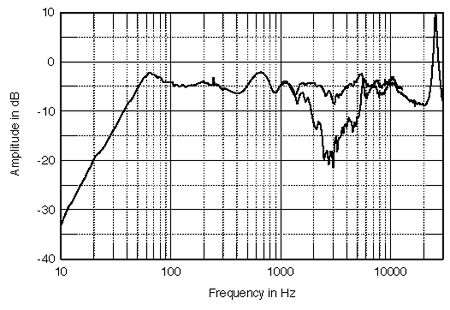
Fig.3 Monitor Audio Studio 50, anechoic response on tweeter axis at 45", averaged across 30° horizontal window and corrected for microphone response, with complex sum of nearfield midrange and woofer responses plotted below 200Hz. The top trace is for the optimum tweeter connection; the trace with the large suckout is with the tweeter connected in inverted acoustic polarity—see the text.
[MC's samples were supplied with the tweeter internally hooked-up out to be out-of-phase in the crossover region, giving the fig.3 trace with the large suckout in the mid-treble when biwired with the units nominally in-phase. The Santa Fe samples had the tweeter connected with the opposite polarity, so that the in-phase connection gave the flat trace in fig.3, the opposite way round to MC's. We experienced a similar drive-unit wiring confusion with the small Monitor Audio Studio 2 speaker that WP reviewed a year ago (February '95, Vol.18 No.2, p.92). Inverting the polarity of that speaker's tweeter connection both swung the optimal listening axis up to something practical and gave much the flattest on-axis response. It appears that Monitor Audio perhaps has a QA problem here. As MC stated earlier, I am sure we will hear from the manufacturer about this phenomenon.—Ed.]
On-axis, the speaker met ±3dB limits all the way to 20kHz, through there was some rolloff in the final audible octave. The peak on the listening axis at 25kHz, due to the tweeter resonance, should hopefully be inaudible. Since the rest of the major amplitude variations are due to minor phase shifts between the mid and treble, it was clear that the Studio 50 has a substantially flat and well-balanced frequency response.
These measurements were all taken without the grille. While the grille is transparent at 15kHz and below 1.5kHz, it imposed up to 2dB of loss in the main treble range and, as such, is no model of acoustic perfection.
Measured with nearfield mike placement, the low-frequency readings showed good uniformity, ±1dB from 60Hz to 200Hz, –3dB by 54Hz, and –6dB at 45Hz, with the anticipated 12dB/octave rollout below the enclosure tuning frequency. With typical room reinforcement, clean (if dry) bass will be available down to 30Hz, but in my view the Studio 50 doesn't meet the specified 25Hz.
Fig.4 shows the vertical response family, the traces referenced to the optimized axial response, the computed straight line. Above-axis, the output is deeply notched, while the variation below-axis is fairly mild. Moving to the lateral off-axis family (fig.5), there is an initial mild shift as the output settles down, and then the correspondence can be seen to be very good, with little variation between the 30° and 45° off-axis outputs.
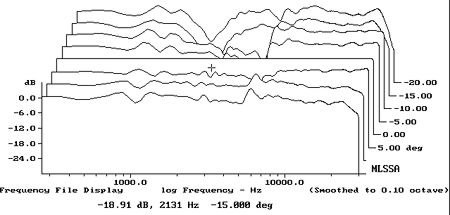
Fig.4 Monitor Audio Studio 50, vertical response family at 45", normalized to response on tweeter axis, from back to front: differences in response 20°–5° above tweeter axis; reference response; differences in response 5°–15° below tweeter axis.
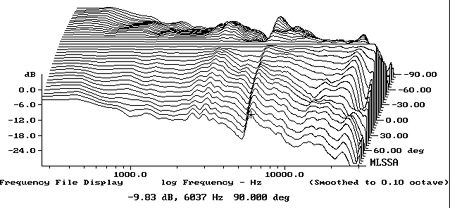
Fig.5 Monitor Audio Studio 50, horizontal response family at 45", normalized to response on tweeter axis, from back to front: differences in response 90°–5° off-axis; reference response; differences in response 5°–90° off-axis.
In the listening room, the '50 gave a wide, well-integrated output, ±4dB 30Hz–8kHz, with a smooth, natural "room" decay thereafter. The desirable lack of energy step through the crossover range was noteworthy, as was the good control of the usual floor-reflection dip between 100 and 200Hz. Here it was limited to a wholly tolerable –3.5dB at 100Hz.
The Studio 50's step response (fig.6) result was tidy enough—noting that the inverted leading edge is due to the tweeter. Prolonged ringing is absent. The phase response on the listening axis was smoother than expected, at +45°–70°, 100Hz–13kHz. Assessing the decay of energy with time, the waterfall representation (fig.7) reveals that the decay rates is very good except for that metal cone ringing at 5.5kHz. Mostly over by 1.5ms, however, it's not so much of an audible problem as it might look. Good behavior was also evident in the low range.
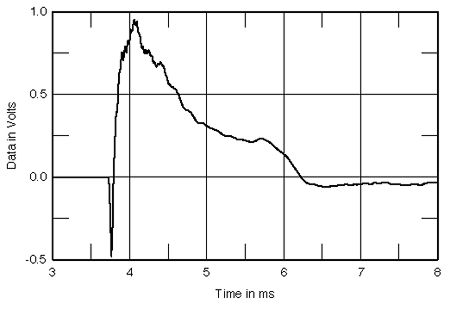
Fig.6 Monitor Audio Studio 50, step response on tweeter axis at 45" (5ms time window, 30kHz bandwidth).

Fig.7 Monitor Audio Studio 50, cumulative spectral-decay plot at 45" (0.15ms risetime).
Spot checks on distortion showed normal values of 0.15 to 0.25% at 90dB spl, 100Hz–15kHz, this the essentially harmless low-harmonic. Distortion rose at the lower frequencies, but held at a satisfactory 5% for 40W output at 40Hz, good for the class. More important, the low end of this speaker sounded clean, unless it was ultimately flattened against the stops.
[Finally, checks on the cabinet vibration that I performed using a simple piezoelectric plastic strip confirmed that the Studio 50's cabinet is effectively braced. Fig.8, a waterfall plot calculated for the output of the accelerometer fastened to the enclosure sidewall about 12" from the floor, reveals a low level of resonant modes and what modes there are have been pushed high enough in frequency by the bracing to have little subjective effect.—Ed.]—Martin Colloms
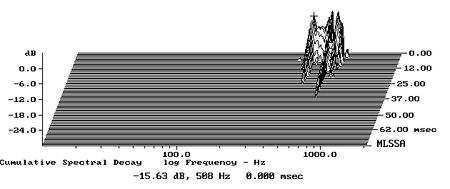
Fig.8 Monitor Audio Studio 50, cumulative spectral-decay plot of accelerometer output fastened to side of enclosure 12" from floor (MLS driving voltage to speaker, 7.55V; measurement bandwidth, 2kHz).
- Log in or register to post comments




































